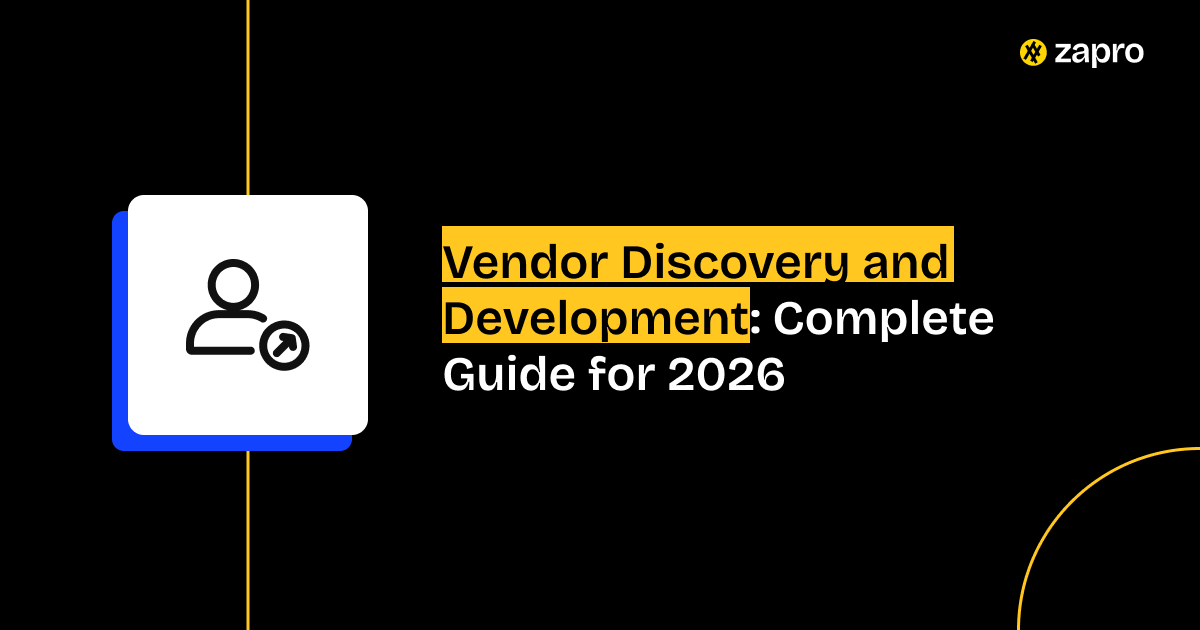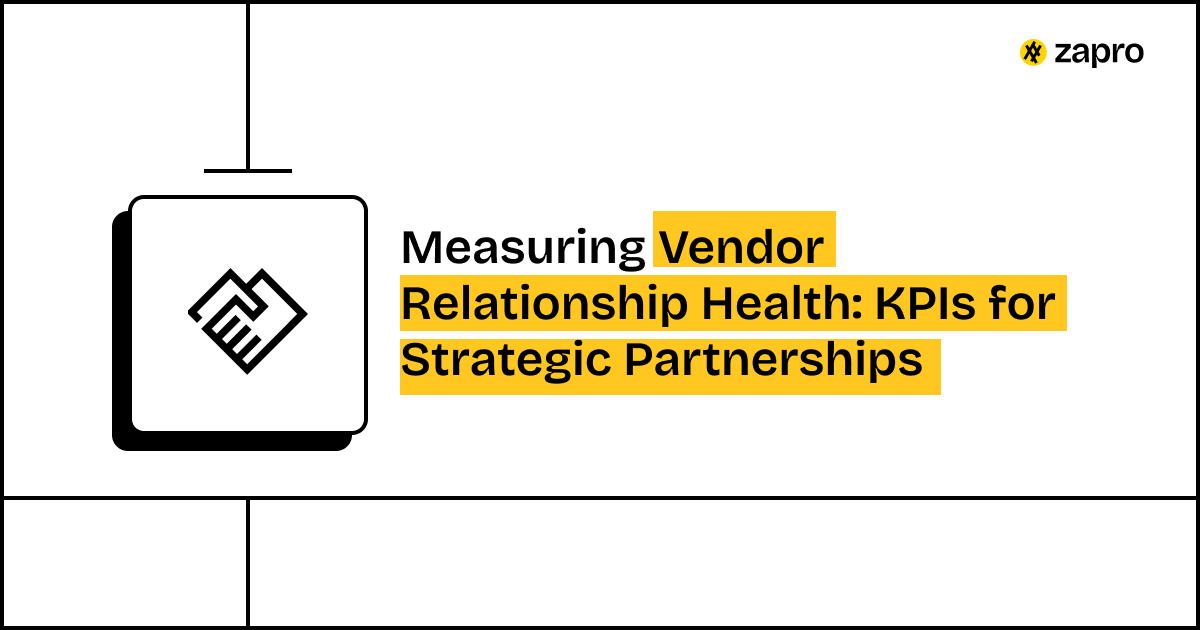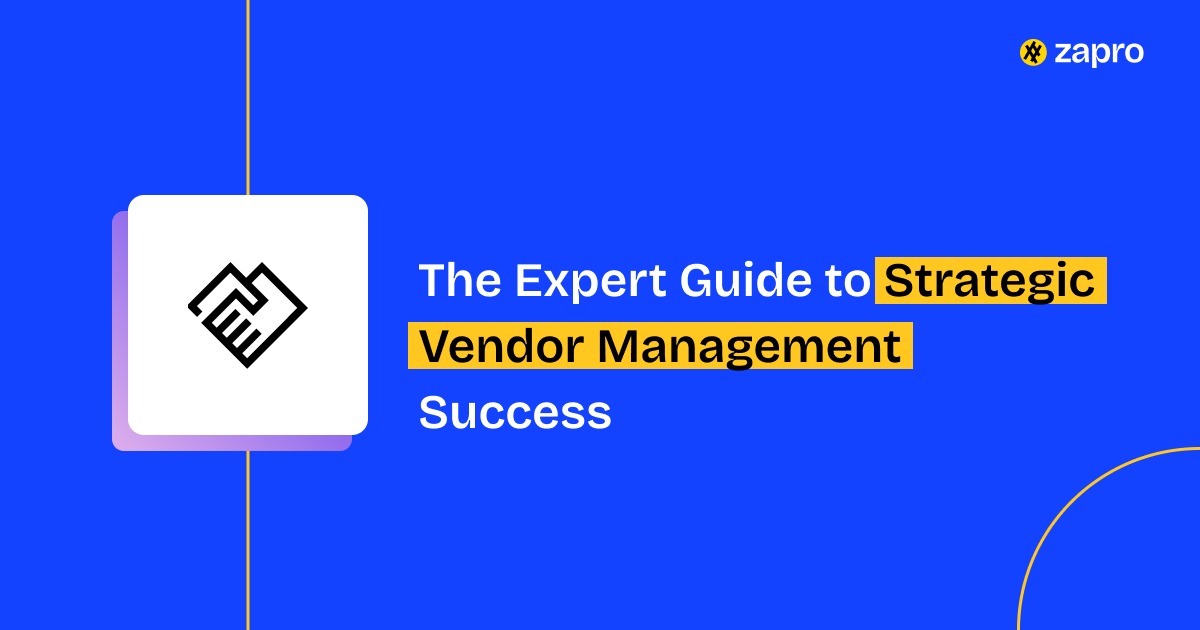You are Here: Vendor Management Solution >> Supplier Performance Management
What is Supplier Performance Management (SPM)?
Supplier Performance Management (SPM) is a strategic process that involves measuring, analyzing, and improving supplier performance to ensure that vendors meet or exceed the expectations defined in contracts, service-level agreements (SLAs), and broader procurement goals. It goes beyond transactional vendor oversight; it’s about creating value, reducing risk, and driving continuous improvement in the supply chain.
At first glance, you might think this sounds like regular vendor management.
But here’s the key difference: Vendor management focuses on what’s happening now like onboarding, tracking POs, paying invoices. SPM, on the other hand, zooms out. It’s forward-looking.
It asks:
- Is this supplier helping us move the business forward?
- Are they delivering value beyond price?
- Can we rely on them when things get tough?
SPM evaluates a range of factors, like:
- Product or service quality
- Delivery timelines
- Cost efficiency
- Regulatory compliance
- Responsiveness and collaboration
So the goal here isn’t just to catch mistakes. It’s to build a better partnership to work together with suppliers to raise performance, solve issues early, and unlock opportunities for growth or innovation.
To truly manage supplier performance, visibility isn’t enough; you need the right metrics. These are what turn guesswork into clear, actionable decisions. Let’s look at the key ones that matter.
What are the key Supplier Performance Management Metrics (KPIs)?

To turn supplier performance management into actionable insight, you need the right metrics. These key performance indicators (KPIs) serve as the foundation for evaluating how well your suppliers are supporting your business goals, from operational efficiency to risk management.
Here are the five essential categories of supplier performance management metrics every procurement team should track:
1. Quality Metrics
These metrics assess the reliability and consistency of the supplier’s outputs:
- Defect Rates: Percentage of delivered goods that fail to meet quality standards.
- Return Rates: Frequency at which materials or products are returned due to defects or non-compliance.
- Customer Complaints: Downstream indicators of poor supplier performance that affect end-user satisfaction.
2. Delivery Metrics
Timely delivery is critical for maintaining production schedules and customer commitments:
- On-Time Delivery Rate: Percentage of orders delivered by the promised date.
- Lead Time: Time taken from placing the order to receiving it a key indicator of responsiveness.
- Order Accuracy: Measures how often deliveries match the order specifications (quantities, SKUs, packaging).
3. Cost Metrics
Monitoring cost-related KPIs ensures suppliers are contributing to overall financial efficiency:
- Price Competitiveness: How supplier pricing compares to industry benchmarks.
- Cost Reduction Initiatives: Collaborative efforts to reduce total landed cost over time.
- Invoicing Accuracy: Ensures billing matches orders and deliveries, avoiding disputes and delays.
4. Responsiveness Metrics
These track how quickly and effectively suppliers address communication and issues:
- Response Time: Speed at which suppliers respond to queries, changes, or escalations.
- Issue Resolution Time: Time taken to resolve quality, delivery, or service-related problems.
5. Compliance Metrics
Critical for risk mitigation and strategic alignment:
- Contract Compliance: Adherence to terms, conditions, and service-level agreements (SLAs).
- Regulatory Compliance: Meeting industry or governmental requirements (e.g., FDA, REACH).
- ESG Alignment: Performance against Environmental, Social, and Governance (ESG) goals increasingly vital in modern supply chains.
| According to a Deloitte report, organizations that implement structured SPM programs see up to 10–15% in cost savings and experience fewer supply chain disruptions, proving the measurable value of data-driven supplier evaluation. |
Building an Effective Supplier Performance Management Framework: Steps and Best Practices
A successful Supplier Performance Management (SPM) program doesn’t happen by accident it’s built on a structured, repeatable framework that aligns procurement strategy with supplier capabilities and business goals.

Supplier performance management isn’t just about measurement; it’s about fostering collaboration and continuous improvement. It’s a partnership, not a policing action.
— Dr. Kate Vitasek, Strategic Sourcing Expert
Below are the core steps and best practices to establish a strong SPM foundation:
1. Set Clear Performance Expectations
Start by defining what success looks like. This means aligning with suppliers on Service Level Agreements (SLAs), performance KPIs, and contract terms. Expectations should be transparent, measurable, and directly tied to operational and strategic priorities.
2. Collect and Analyze Performance Data
Use automated tools or scorecards to capture data across all key dimensions—quality, delivery, cost, responsiveness, and compliance. Don’t just track incidents; look for patterns that may reveal systemic issues or opportunities.
3. Conduct Regular Performance Reviews
Schedule periodic check-ins with suppliers to review performance data, discuss concerns, and explore areas for improvement. These reviews foster accountability and give both parties a forum to align on current and future goals.
4. Develop Improvement Plans (CAPAs)
When issues arise, create Corrective and Preventive Action Plans (CAPAs). These should include clear timelines, responsibilities, and measurable outcomes. The goal is not just to fix problems but to prevent them from recurring.
5. Implement a Continuous Feedback Loop
SPM should be a living process. Encourage ongoing feedback from internal stakeholders and suppliers. Leverage this input to refine KPIs, update review cadences, and continuously raise performance standards.
By following this framework, procurement teams can move from reactive firefighting to proactive supplier enablement ensuring long-term value creation rather than short-term fixes.
How to Drive Supplier Improvement: 5 Strategies that Actually Move the Needle
Once performance gaps are identified, the next step is enabling suppliers to improve—not through top-down directives, but through collaborative, value-driven initiatives. Supplier improvement should be a joint effort that not only resolves issues but also strengthens long-term partnerships.
Here are five actionable strategies to drive meaningful supplier performance improvement:
1. Collaborate on process improvement initiatives
Improvement starts with alignment. Sit down with your key suppliers to identify bottlenecks, inefficiencies, or quality concerns and solve them together. These joint initiatives might include:
- Redesigning workflows to reduce lead times
- Standardizing quality checks to cut defect rates
- Digitizing order or invoice processes
- When suppliers are actively involved in these improvements, they’re more invested in sustaining results.
2. Provide training and development programs
Not every performance issue is rooted in intent—many stem from capability gaps. Offer training sessions, onboarding documentation, or tools to help suppliers better meet your standards. Some examples include:
- Quality control workshops
- Compliance training for ESG or regulatory updates
- Digital platform onboarding for e-procurement tools
Investing in supplier education creates a more consistent and capable supply base.
3. Launch supplier innovation programs
Great suppliers often bring fresh ideas to the table, if you create space for them to do so. Formal innovation programs can invite them to propose:
- New materials or production techniques
- Product enhancements or design feedback
- Cost-saving process alternatives
By recognizing and rewarding supplier-led innovation, you tap into a powerful engine for competitive advantage.
4. Use tiering to manage suppliers differently
One-size-fits-all doesn’t work in supplier management. Segment your suppliers based on strategic value, spend, or risk:
- Tier 1 suppliers (critical or high-spend): Get frequent performance reviews, executive visibility, and collaborative improvement plans.
- Tier 2 suppliers: Managed more tactically, with periodic check-ins and standard metrics.
- Tail spend suppliers: Monitored with basic compliance tools or automated dashboards.
This allows you to focus your time and resources where they matter most.
5. Tie performance to incentives
Incentivizing performance isn’t just about bonuses, it’s about preferred access. Consider offering:
- Larger contract opportunities for consistently top-performing suppliers
- Faster payment terms as a reward for reliability
- Recognition through supplier awards or feature spots in case studies
Incentives aligned with metrics create positive pressure and drive real accountability.
| TREND TO WATCH Sustainability and ethics are becoming core to supplier improvement efforts.More organizations are integrating Environmental, Social, and Governance (ESG) criteria into supplier evaluations—tracking carbon emissions, labor practices, and ethical sourcing as part of their performance reviews. According to McKinsey, companies that embed sustainability into supplier programs see both reputational and operational benefits. |
The Role of Technology in Modern Supplier Performance Management
Gone are the days of managing supplier performance with spreadsheets, email threads, and siloed data. Today, technology plays a central role in helping procurement teams move from reactive monitoring to proactive, insight-driven supplier management.
Here’s how modern vendor management tools are reshaping Supplier Performance Management (SPM):
1. Automated data collection reduces manual effort
Modern SPM platforms integrate with ERPs, procurement software, and third-party systems to automatically capture key performance data delivery timelines, quality issues, invoice accuracy, compliance flags, and more.
This eliminates the need for manual reporting and ensures accuracy and timeliness across every metric.
2. Real-time dashboards provide instant visibility
Visual dashboards let teams track performance KPIs across suppliers at a glance. Whether it’s on-time delivery rates, defect trends, or contract compliance, procurement managers can:
- Spot deviations immediately
- Drill into supplier-specific data
- Compare performance across tiers or categories
No more waiting for quarterly reviews, actionable insights are now available on demand.
3. Centralized communication keeps everyone aligned
Integrated messaging and feedback loops within SPM tools make it easy to document conversations, clarify expectations, and follow up on corrective actions.
This ensures both your internal teams and suppliers are on the same page literally.
4. Predictive analytics help prevent problems before they happen
Advanced SPM systems use AI and machine learning to detect early warning signs like a gradual drop in delivery punctuality or repeated invoice discrepancies.
This allows teams to address issues before they snowball into major disruptions, improving both agility and risk management.
5. Integration with vendor management systems (VMS)
SPM software often works alongside broader vendor management systems, giving teams a single source of truth for:
- Supplier profiles
- Compliance documentation
- Audit trails of performance history
When everything is connected, decision-making becomes faster, clearer, and more strategic.
Technology doesn’t just streamline SPM, it transforms it from a reactive function into a proactive, value-driving capability.
How Zapro.ai powers your supplier performance management
Managing supplier performance is easier and smarter with the right tools. Zapro.ai gives procurement teams everything they need to track, evaluate, and improve supplier outcomes in one unified platform.
Here’s how it helps:
Custom dashboards with real-time insights
Visualize supplier KPIs quality, delivery, cost, and more in a single, customizable dashboard. Filter by supplier, category, or region to focus on what matters most.
Automated data collection
Zapro pulls performance data directly from your procurement systems no more manual updates or data silos. Your scorecards stay accurate and current, always.
Performance scorecards for better accountability
Each supplier gets a dynamic scorecard built on predefined KPIs. These are easy to share during reviews and help guide improvement discussions.
Built-in communication tools
From feedback to corrective actions, everything is tracked in one place. No more digging through email chains Zapro keeps supplier collaboration organized and transparent.
Risk alerts and audit trails
Get notified when performance dips. Zapro also maintains a complete history of supplier data, helping with audits, negotiations, and strategic planning.
With Zapro.ai, SPM becomes proactive, efficient, and fully integrated into your vendor management workflow.
Improve your supplier relationship in just a click!

Case study: How a manufacturing company boosted on-time deliveries by 22% with Zapro.ai
Industry: Mid-size manufacturing
Challenge: Frequent delays and inconsistent quality from tier-1 suppliers were disrupting production schedules and increasing operational costs.
Before Zapro, the company relied on spreadsheets and email to monitor supplier performance. Reviews were inconsistent, data was outdated, and underperforming suppliers weren’t being flagged early enough.
What changed with Zapro.ai:
- Real-time dashboards highlighted drops in delivery and quality scores instantly.
- Automated scorecards helped benchmark performance across 25+ suppliers.
- Quarterly reviews became data-driven, with clear action plans for improvement.
- Built-in communication tools enabled faster follow-ups on issues.
The result?
- 22% improvement in on-time delivery within six months
- 30% reduction in quality-related rework
- Faster issue resolution through structured workflows
- A more collaborative supplier ecosystem that prioritized performance and growth
Zapro turned supplier reviews from a reactive chore into a strategic advantage.
Calculating the ROI of investing in SPM with Zapro.ai
Supplier performance directly impacts your bottom line from cost of defects to missed delivery windows. With Zapro.ai, procurement leaders gain measurable returns on their SPM investments.
Here’s how Zapro helps unlock ROI:
1. Lower defect and rework costs
By improving quality metrics, teams reduce scrap, returns, and downstream rework.
2. Better on-time performance = fewer delays
Timely deliveries help avoid production halts, expedited shipping, and customer dissatisfaction.
3. Improved compliance and risk reduction
With real-time alerts and audit trails, companies avoid costly penalties or contract breaches.
4. Stronger negotiation leverage
With transparent performance history, you can renegotiate contracts or shift volumes toward high-performing suppliers.
Estimated ROI:
Companies using robust SPM platforms like Zapro.ai typically see:
- 10–15% in cost savings
- 20–25% boost in supplier responsiveness
- Fewer disruptions and more predictable supply chain operations
For exact projections, try Zapro’s ROI calculator (simulated).
Choosing the right Supplier Performance Management solution: A quick checklist
When evaluating a Supplier Performance Management platform, here’s what to look for:
- Customizable KPI tracking: Can you set metrics based on your specific goals?
- Automated data collection: Is performance data synced in real time from your systems?
- Visual dashboards and scorecards: Are insights easy to access and share with stakeholders?
- Alerts and risk monitoring: Will it notify you before performance problems escalate?
- Collaboration tools: Is there a shared space for communication and corrective action?
- Audit trails and reporting: Can you track historical data for compliance and negotiation?
- Integration readiness: Does it work well with your ERP or procurement tools?
- Scalability and usability: Can it support growing teams without steep training curves?
Zapro.ai checks all these boxes, making it a smart fit for modern procurement teams focused on accountability, visibility, and continuous improvement.
Ready to transform supplier management into a strategic advantage?
Get in touch with our team or explore how Zapro can fit into your workflow.
Improve your supplier relationship in just a click!

Frequently Asked Questions (FAQs)
1. What is the difference between SPM and SRM (Supplier Relationship Management)?
Supplier Performance Management (SPM) focuses on measuring, evaluating, and improving supplier outputs based on key metrics like quality, delivery, and compliance.
Supplier Relationship Management (SRM) is a broader process. It emphasizes collaboration, strategic alignment, and long-term value creation across the supplier lifecycle. You can think of SPM as a subset of SRM.
2. How often should supplier performance be reviewed?
Review frequency depends on the supplier’s criticality. For strategic or high-risk suppliers, performance should be reviewed quarterly or even monthly. For non-critical vendors, semi-annual or annual reviews may be sufficient.
3. What are common pitfalls in SPM implementation?
Some typical challenges include:
- Tracking too many or irrelevant KPIs
- Lack of timely or accurate data
- One-sided evaluations (no supplier input)
- Failing to act on performance insights
- Poor alignment between procurement and business goals
4. How does SPM contribute to risk management?
SPM helps flag early warning signs like missed deliveries, quality issues, or compliance lapses. With consistent tracking, companies can proactively mitigate operational, financial, and reputational risks tied to supplier performance.
5. Can SPM be applied to all types of suppliers?
Yes, but the depth of performance monitoring should vary by supplier type. Strategic and high-spend suppliers require robust evaluation, while transactional vendors may only need basic performance checks.
6. What is a supplier scorecard?
A supplier scorecard is a structured tool used to track and visualize a supplier’s performance across key KPIs over time. It often includes metrics like defect rate, on-time delivery, responsiveness, and contract compliance enabling data-driven decisions and accountability.
Don’t miss our weekly updates
We’ll email you 1-3 times per week—and never share your information.

 Healthcare
Healthcare Financial Services
Financial Services Technology
Technology Venture Capitalist
Venture Capitalist Chief Procurement Officer
Chief Procurement Officer Chief Financial Officer
Chief Financial Officer




